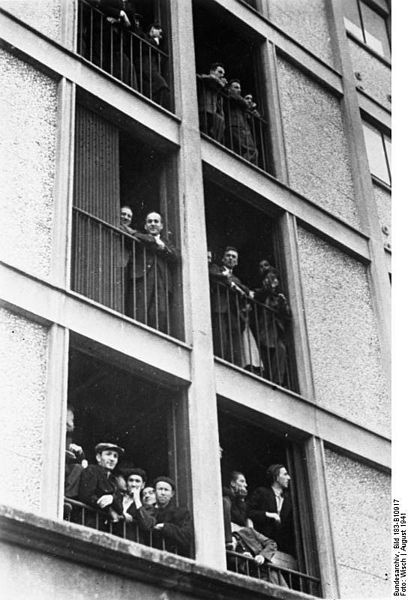On August 17, 1944, the last convoy of deportees left the Drancy camp for Germany. The following day, 1,467 prisoners were freed after the arrival of the Swedish diplomatic representative and members of the Red Cross.
Located in the eastern suburbs of Paris, the Cité de la Muette de Drancy, consisting of a long U-shaped four-storey building and five towers, was built in the early 1930s by architects Eugène Beaudoin and Marcel Lods, who wanted to make it a model of architectural modernity.
Its construction was hampered by economic problems, and it was taken over by the Germans and the Vichy regime. In 1940, it became an internment camp, with no heating, no sanitary facilities, no glass windows and a concrete floor. From then on, the courtyard was enclosed by barbed wire and the floor covered with clinker. Barracks for latrines and watchtowers at the four corners of the courtyard were installed by the French gendarmerie, who ran the camp.
A terrible example of the criminal collaboration between the Nazis and the Vichy authorities, the Drancy camp took in prisoners of war from June 1940 onwards - Communist prisoners as soon as the German-Soviet pact was signed, German prisoners, French soldiers - and foreign civilians.
On August 20, 1941, the Drancy camp became an internment camp for Jews. 4,230 men, 1,500 of them French, rounded up in Paris between August 20 and 25, were the first Jewish internees at the Drancy camp. They were the first names on a long list of 76,000 men, women and children who would spend anywhere from a few days to several months at Drancy-la-Juive - as it was known at the time.
Crammed 50 to a room, the interned Jews, stripped of their identity papers and money beforehand, slept on the cement floor, without mattresses or blankets. Starvation quickly set in; internees received 250 grams of bread a day from their captors. Outings were limited to one hour a day, sanitary conditions were insalubrious, and dysentery and vermin were rife.
At once a reprisal, transit and concentration camp, the Drancy camp became, under French administration and German command, theantechamber to the camps of the East; the last stage before the gas chambers of Auschwitz-Birkenau and the other concentration and extermination camps of the Reich. The first convoy to Auschwitz leaves Drancy on March 27, 1942.
Over the following months, 63 convoys set off from the Bourget-Drancy station - and then from the Bobigny station - for the extermination camps, carrying 65,000 people. In France, nine out of ten Jews deported during the Holocaust passed through the Drancy camp.
In June 1943, the Drancy camp came under complete German control. An Austrian SS commando led by Aloïs Brunner took over administration of the camp from the Préfecture de Police. But the latter was cooperating less and less with the Germans. Brunner further accelerated the deportation of Jews from France .
On August 17, 1944, just a few days before the Liberation of Paris and at a time when the German army was facing a real debacle, Aloïs Brunner succeeded in organizing a last convoy from Drancy. On board were 51 deportees bound for the Buchenwald camp, as well as Brunner himself and other SS men fleeing France. 39 people managed to escape from the wagons before arriving in Germany.
At the camp, the internees managed to save archives from destruction by the Germans, who eventually decamped. On August 18, 1944, 1,467 prisoners were liberated from the Drancy camp.
More information
Photographs: ©Bundesarchiv, Bild 183-B10920 / Wisch / CC-BY-SA 3.0 ©Bundesarchiv, Bild 183-B10917 / CC-BY-SA 3.0



















